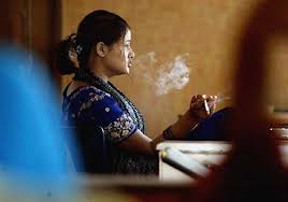 NEW DELHI: Female smokers in India has gone up in the last 30 years but the number of men who puff daily dipped in the country where more people are smoking today, say researchers.
NEW DELHI: Female smokers in India has gone up in the last 30 years but the number of men who puff daily dipped in the country where more people are smoking today, say researchers.
Smoking among Indian men fell from 33.8 per cent in 1980 to 23 per cent in 2012 while female smoking in 2012 was 3.2 per cent, almost the same as in 1980 (3 per cent), says a new study on global smoking prevalence published earlier this month in the Journal of the American Medical Association.
In the year 2012 a total of 12.1 million women smoked in India, compared to 5.3 million female smokers in 1980 while the prevalence of male smokers was estimated to be 98 million in the same year. Smokers in India also consumed an average of 8.2 cigarettes per day said the report.
United States had 14.3 per cent women smokers followed by Russia and Nepal (both 16.9 per cent), Brazil (11 per cent) Pakistan (5.4 per cent) Indonesia (3.6 per cent) India (3.2 per cent) China (2.1 per cent) Bangladesh (1.8 per cent) and Sri Lanka (1 per cent).
The study, titled “Smoking Prevalence and Cigarette Consumption in 187 Countries, 1980-2012,” by Seattle-based Institute for Health Metrics and Evaluation (IHME)referred to in-country surveys, government statistics and data by the World Health Organization.
Also India gained 35 million smokers totaling to 110 million despite a fall in the smoking rate from 19 per cent to 13 per cent of the population, said the study published in the in the Journal of the American Medical Association (JAMA).
The report found that global smoking rate among men was 41 per cent in 1980, but declined to an average of 31 per cent.
Among women, the estimated prevalence of daily tobacco smoking was 10.6 per cent in 1980 and by 2012 that had fallen to 6.2 per cent.
“India is currently in the phase 2 of the tobacco epidemic, which follows a cyclical pattern. While there are male smokers, women smokers follow the trend in this phase,” points out Dr Monika Arora, Senior Director, HRIDAY, a voluntary organization working in the field of health promotion among adolescents in India.
She says the number of women smoking in urban areas has increased. “We did a survey of schools in Chennai and Delhi and found that the there is a very narrow gender gap among adolescents who are smoking. The prevalence of overall tobacco use among men is 47 per cent and women 21 per cent in the country,” says Monika.
The glamorization of smokers in Bollywood films and advertisements till very recently could be one factor which has contributed to the rise of smoking among women, she says.
“The government has now curtailed such visuals on TV and in films. Another factor to be considered here is that India is very different from other countries. It has a peculiar problem of smokeless tobacco and we have to look at that pattern too,” says Monika.
The IHME study, however, does not factor in smokeless tobacco, including chewing products such as gutkha, zarda, paan masala and khaini, which is the most common form of tobacco use in India.
“Women smoke due to a variety of factors. Apart from stress and peer pressure, the need for adventure and easy availability lead women to take up smoking,” Dr Rajiv Mehta, Consultant Psychiatrist at Sir Ganga Ram Hospital told PTI.
According to research smoking has been found to have numerous health risks especially for women including increasing the risk of stroke and heart disease among them.
The WHO links smoking with 25 women’s cancers – lung, cervix, breast and colon and second hand smoke raises the risk of breast cancer.
In 2003, the Framework Convention on Tobacco Control was adopted by the World Health Assembly and has been ratified by 177 countries.
“Despite the tremendous progress made on tobacco control, much more remains to be done,” said Dr Christopher Murray, director, the Institute for Health Metrics and Evaluation.
“We have the legal means to support tobacco control. Where we see progress being made we need to look for ways to accelerate that progress. Where we see stagnation, we need to find out what’s going wrong,” he said.
Globally, the number of smokers went up from 721 million in 1980 to 967 million in 2012. -PTI






